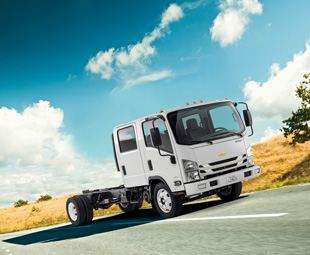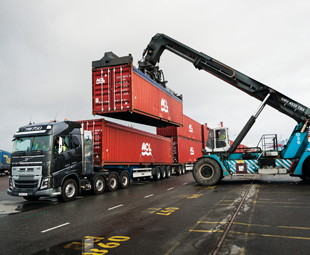Isuzu expands US market presence

In his monthly review of global news for local truckers, FRANK BEETON records Isuzu’s plans to expand its presence in the important United States (US) truck market; reports on some new Sprinter developments and speculates that more may be on the way; unpacks Volvo’s latest publicity stunt; and details Eicher’s new entry to the Indian light truck market.
North America is an extremely important market for Japanese truck and diesel-engine manufacturer Isuzu Motors Limited. Since its own initial entry into that market in 1984, Isuzu has established itself as the leading supplier of low-cab forward-control trucks.
An important element of Isuzu’s North American success was a marketing and manufacturing partnership with General Motors (GM). This added some 470 GM dealers to Isuzu’s own 250-strong network, and led to petrol-engined derivatives of the trucks, which were built in GM plants. This arrangement was unilaterally terminated by the American company in 2009, by which time Isuzu had sold more than 400 000 units in North America.
In 2014, however, a revised cooperative arrangement between Isuzu and GM was announced. As part of this, North-American assembly of Isuzu-sourced products (including those carrying Chevrolet branding), would now be carried out by Spartan Motors in Charlotte, Michigan, and not, as before, in General Motors’ own plants.
Since then, another cooperative venture has emerged, which will see GM sourcing a range of conventional (bonneted) trucks from Navistar International Corporation. This vehicle configuration, which remains important in the US market context, will be built by Navistar and not in GM’s own production facilities.
Latest American Isuzu and Chevrolet truck line-ups
The initial range covered by the revived Isuzu/GM arrangement is based on Isuzu’s N-Series “low-cab forward-control’ light truck line-up. It includes Chevrolet-branded models, badged as the 3500/4500/5500 range, all with the choice of 6,0-litre, GM V8 petrol engines and Hydra-Matic, six-speed fully automatic transmissions. These will be offered alongside Isuzu’s own 3,0-litre and 5,2-litre turbodiesels.
The models developed, built and supplied by Navistar, which will come to market in 2018, are conventional cab Class 4/5 trucks (roughly 6,4 – 8,9 t gross vehicle mass (GVM) ratings) and will be sold with Chevrolet branding.
During the period before the GM partnership was revived, Isuzu was obliged to make a new set of arrangements to safeguard and consolidate its position as a supplier to this important market, and to ensure the continued availability of petrol-engined N Series trucks.
Accordingly, production was relocated, in September 2011, to Spartan Motors, Inc. – a well-known specialist manufacturer of emergency, recreational, defence and delivery vehicles – and this arrangement has continued into the second era of partnership with GM.
Isuzu’s American F-Series
With the new arrangements now in place, Isuzu has announced, at the 2016 Work Truck Show in Indianapolis, that it will be expanding its North American range to include a larger F-Series FTR-designated model, which will compete at the upper limits of Class 6 (GVM ratings from approximately 8,8 to 11,8 t).
This forward-control (cabover) 4×2 model will be powered by Isuzu’s 5,2-litre, four-cylinder 4HK1-TC turbocharged diesel, driving through an Allison 2000 Series fully automatic transmission. The specification will include eight wheelbase options, allowing body lengths of up to 14,2 m.
During April, Spartan Motors held a groundbreaking ceremony for a new 8 000 m² assembly plant in Charlotte, which will build Isuzu’s F-Series trucks from mid-2017. It seems that Isuzu will not be offering a petrol-engined variant of the FTR to North American operators, but rather selling the fuel economy, operational and vehicle-mass benefits of a relatively small displacement diesel engine and large fuel-tank capacity to that market.
NEW SPRINTER VARIANTS, BUT IS THAT ALL?
Mercedes-Benz has announced the introduction of new Sprinter van variants for the European market. It has a 5,5 t GVM rating, up from the previous five tonne limit, and new Euro-6 engine output ratings of 84 kW (114 hp) and 105 kW (142 hp), replacing previous 70 kW and 95 kW versions. The higher power options of 120 kW (163 hp) and 140 kW (190 hp) will still remain in the catalogue.
 Mercedes-Benz says that the increased GVM availability is intended to address the requirements of operators in the building, passenger-transport, ambulance and fire-services sectors, which often require vehicles to be tailored to their particular requirements, and have previously needed to seek special authorisation for increased operating masses.
Mercedes-Benz says that the increased GVM availability is intended to address the requirements of operators in the building, passenger-transport, ambulance and fire-services sectors, which often require vehicles to be tailored to their particular requirements, and have previously needed to seek special authorisation for increased operating masses.
These new enhancements have been applied to the present generation Sprinter range, but we cannot help thinking that something far more significant may be lurking in the wings, possibly awaiting revelation at this year’s IAA Show in Hannover.
Other European van news includes the upcoming introduction of Nissan’s NV300 replacement for the European Primastar model. Last month, in our report on Fiat Professional’s new Talento van, we mentioned that this product would be manufactured at Renault’s recently upgraded Sandouville plant in France, alongside its Renault Trafic and Opel/Vauxhall Vivaro siblings, in addition to the new NV300.
The Primastar was previously manufactured in Barcelona, Spain, and the new arrangement reflects a further consolidation within the Renault-Nissan alliance, adding an additional 100 000 units to Sandouville’s annual production volume.
This plant had previously been used to build Renault’s larger passenger car models, but falling demand prompted a €230 million investment in facility changes, and a shift to commercial van production.
Further Daimler/Renault links in the offing?
No specific details of the NV300 have emerged as yet, but it can be expected that it will be similar to the Talento with diesel engines rated up to 110 kW (145 hp), a payload capacity of 1,2 t, a load volume of 6 m³, but feature some unique Nissan front-end styling.
However, the intriguing question still remains regarding future cooperation between this Renault-led van grouping and Daimler AG. As we have noted previously, the joint van-building venture between Mercedes-Benz and Volkswagen, which produced the respective brands’ Sprinter and Crafter ranges, is due to terminate in the second half of this year, which, as you read these words, is almost upon us.
Daimler and Renault-Nissan have enthusiastically advanced their cooperation over the past five years, covering some 13 joint projects. The most recent of these have been the groundbreaking on a joint Mexican assembly plant, and the announced development of a Mercedes-Benz branded one-tonne pickup derived from the all-new Nissan NP300 platform. Other cooperation in the commercial vehicle market – in the form of the Mercedes-Benz Citan light van, spun off from the Renault Kangoo – is already well established.
The question whether this cooperation will extend upwards to involve future replacements for Mercedes-Benz models, such as the Vito and Sprinter, remains unanswered. Possibly, this may encroach too closely on Mercedes-Benz’s proud truck culture to happen, but economic priorities may well intervene. Renault can offer a real critical-mass benefit in these commercial vehicle classes, which will argue strongly in favour of extended cooperation.
In our report on MAN’s impending entry to the van business with a product spun-off from Volkswagen’s (VW’s) new stand-alone Crafter, there was considerable evidence that VW’s current Sprinter-influenced design configuration (which was entirely logical when both products were built in the same Daimler-owned plant) is about to be changed.
In the new independently developed product, rear-wheel-drive will be supplemented by front- and all-wheel drive options. Will Mercedes-Benz continue to compete in this class for any length of time with just a mildly facelifted Sprinter? We don’t think so!
The evidence mounts
Notwithstanding its hugely successful history, with more than three million units sold, Sprinter is now becoming an increasingly important global product, with growing success in the hugely significant North American market.
As we reported earlier, Daimler Trucks has announced that a new van manufacturing plant is to be opened in Charleston, South Carolina during this year to build the “next generation Sprinter” for the American market.
It was also announced that €450 million (about R8 trillion) is being invested in modernising the two German plants in Ludwigsfelde and Düsseldorf, and that the latter would become the global competence centre for the Sprinter product family.
Even though these announcements suggest a continuation of an independent course for Sprinter, we still wouldn’t bet against some form of cooperation with Renault in the medium/heavy van arena.
VOLVO MOVES A SERIOUS PAYLOAD
The Volvo Truck Group has established a recent tradition of conducting spectacular stunts to illustrate new product features. Readers may well remember the “Ballerina Stunt”, in which highliner Faith Dickey walked a tightrope stretched between two moving trucks; the ”Jean-Claude Van Damme Splits Stunt”; and others of that ilk.
 Although these stunts were all obviously over-the-top, there can be no doubting their popularity and effectiveness in generating huge publicity for the brand.
Although these stunts were all obviously over-the-top, there can be no doubting their popularity and effectiveness in generating huge publicity for the brand.
During March, Volvo announced the availability of up to two forward and reverse crawler gears in its I-Shift automated transmission range. Crawler gears have extremely high numerical reduction ratios, allowing the vehicle to operate at very low speeds, in this case 0,5 – 2 km/h, while increasing tractive effort, and reducing the tendency to break traction into wheelspin.
The available crawler options include a single 19:1 ratio for direct-drive transmissions, a single 17:1 ratio in overdrive gearboxes, a lowest ratio of 32:1 in the case of the twin crawler option, and a lowest reverse ratio of 37:1 when dual reverse crawlers are fitted (note: “low” ratio equals high numeric ratio).
The plot thickens
Volvo claims that its products equipped with the crawler gear I-Shift option can move off from standstill drawing a gross combination mass (GCM) of up to 325 t. While this is spectacular enough, the company decided to reinforce the point by doing something even more outlandish in the Port of Gothenburg, Sweden.
A 300-m long “road train” was assembled consisting of a FH16 prime mover coupled to 20 trailers. By double-stacking 40 containers loaded with spare parts on the trailers, a combination mass exceeding 750 t was built up.
The “mix” was completed by the addition of Magnus Samuelsson, former holder of the “World’s Strongest Man” title, who was tasked to drive the rig, and British journalist, Brian Weatherley, to act as passenger/observer.
The task set for the rig was to move off from standstill under its own power and cover a distance of 100 m. This was duly achieved after the fifth-wheel base plate was reinforced, all couplings were thoroughly checked, and every one of the 204 tyres supporting this incredible load set to the correct pressure.
Volvo claims that the 551 kW (750 hp) FH16 used for this exercise was in a totally standard configuration, fitted with the heaviest axle options from the available product catalogue. Volvo placed the feat in context by reminding us that 750 t equates to the combined mass of 150 fully grown elephants, or four Boeing 747 Jumbo Jets!
Volvo’s appetite for publicity
Up to 2013, we reported extensively on manufacturers’ efforts to develop and produce the world’s most powerful production truck. However, the final implementation of Euro-6 emission standards at the end of that year appeared to have put some kind of lid on that particular subject.
For the record, the title holder up to September 2011 was Volvo Trucks, with its 551 kW (750 hp) version of its FH16 flagship, which assumed ascendency at that time. It had surpassed Scania’s 537 kW (730 hp) V8 Series (introduced in April, 2010), Volvo’s 522 kW (700 hp) FH16 with D16G engine (announced in September 2008), MAN’s 500 kW (680 hp) TGX with D28 engine (introduced in 2007), Volvo’s 492 kW (660 hp) FH16 (launched in 2006) and Mercedes-Benz “Black Edition” Actros, with 456 kW (612 hp) of OM 502 power (launched in 2004).
The frequency of Volvo’s name appearing in this list does indicate that the manufacturer truly understands the value of publicity, and had deliberately diverted its efforts into alternative directions once the power race option lost its potential.
Taken in isolation, engine power outputs are impressive, but somewhat meaningless. For a truck to be an effective transportation tool, it needs an appropriate mix of engine power, torque, transmission ratios, final drive ratios, aerodynamics, brakes and a host of other factors that, in recent years, have become increasingly subject to electronic management.
We are not sure if Volvo’s feat in moving 750 t with a standard production truck will lead to a spate of similar events, but it does present a new arena of possible challenge for other brands to consider. Moving huge tonnages a short distance does not represent a practical transport task, but it does say much about the safety margins built into modern vehicle design.
EICHER’S NEW LIGHTWEIGHT
Staying with the Volvo Group, but moving to the opposite end of the payload spectrum, we have recently noted the launch of Indian affiliate Eicher’s new Pro 1049 light truck model. Part of the
Pro 1000 range first announced at the end of 2013, this new model is rated at 4 995 kg GVM. With its
2 750 mm wheelbase dimension it can accommodate a 3 068 mm cargo body.
It is powered by Eicher’s four-cylinder, 3,3-litre E483 turbocharged and intercooled diesel, which develops 70 kW (95 hp) and complies with India’s Bharat Stage III (equivalent to Euro 3) emission standards.
The specification includes a five-speed synchromesh transmission, power steering with tilt/telescopic steering column adjustment, hydraulic braking system with air option, exhaust brake, and semi-elliptical steel leaf springs front and rear.
The Pro 1049 is typically intended for use in agriculture, consumer goods distribution, parcel/courier services, and other similar small payload, “last- mile” delivery applications.
Notably, it is marketed under the Eicher Trucks & Buses banner, this being a component of the 50-50 joint venture between the Volvo Group and Eicher Motors Limited, which trades generically as VE Commercial Vehicles Limited.
The Eicher Pro 1000 Series, which participates in the five to 14-t GVM category of the Indian domestic market, carries what appears to be a heavily facelifted version of the Mitsubishi Canter-derived cab, which was carried over from Eicher’s earlier cooperation with that Japanese manufacturer.
Local implications?
We have seen no further evidence of the impending re-entry of Eicher products in to the South African market under Volvo patronage. Earlier announcements made by Group executives raised expectations that these products would fill some of the gap left in the Group’s local product line-up by the final run-out of UD’s U41 Series early in 2015, but this subject has not resurfaced in recent press briefings.
The availability of suitably positioned products from the Eicher source to replace UD’s aging local MCV and HCV product line-ups seemed to present a logical future direction for the Volvo Group to defend its substantial recent participation in these market segments, once the current UD-sourced products were discontinued. However, this possibility now seems to have diminished, and we await news of further developments in this area with interest.
Global FOCUS is a monthly update of international news relating to the commercial vehicle industry. It is compiled exclusively for FOCUS by Frank Beeton of Econometrix.
Published by
Focus on Transport
focusmagsa




